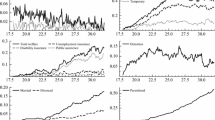Abstract
The fundamental objective of this paper has been to reinvestigate the relationship between employment and crime, while taking account of deterrence, age and race effects. The data, a sample of Brooklyn arrestees, was collected by the Vera Institute of Justice simply to explore, with individual data, the relationship between employment and crime. In this research, a labor theoretic formulation is used incorporating a model that views the problem as one of rational choice between legitimate work and participation in crime. Factors affecting the diminution of crime participation with age are investigated. Changes at age 18 in economic opportunities and in deterrence effects from moving from juvenile to adult status are found to have a significant impact on crime participation. The results are important because they tend to confirm with official crime report data, results found in earlier studies using self-report data, i.e., (1) when the process is appropriately modeled, previous contacts with police are found to cause some experimenters with crime to become desisters, (2) prior work experience and economic opportunities tend to reinforce this tendency to desist, (3) even though blacks are found to have a greater prevalence of involvement in crime, when the data are standardized for all of the aforementioned factors and educational attainment, there is no significant difference between blacks and whites in their tendency to recidivate.
Similar content being viewed by others
References
Farrington, D. P. (1986). Age and crime. In Tonry, M., and Morris, N. (eds.),Crime Just. Ann. Rev. Res. 7: 189–250.
Freeman, R. B. (1983). Crime and the labor market. In Wilson, J. O. (ed.),Crime and Public Policy, Institute for Contemporary Studies, San Francisco.
Freeman, R. B., and Holzer, H. J. (eds.) (1986).The Black Youth Employment Crisis, University of Chicago Press, Chicago.
Good, D. H., Pirog-Good, M. A., and Sickles, R. C. (1986). An analysis of youth crime and employment patterns.J. Quant. Criminol. 2: 219–236.
Good, D. H., and Pirog-Good, M. A. (1987a). The simultaneous probit model of crime and employment for black and white teenage males.Rev. Black Polit. Econ. 16(2): 109–128.
Good, D. H., and Pirog-Good, M. A. (1987b). Employment, crime and race.Contemp. Policy Issues 4: 91–104.
Gronau, R. (1974). Wage comparisons—A selectivity bias.J. Polit. Econ. 82(6): 1119–1155.
Myers, S. L., Jr. (1983). Estimating the economic model of crime: Employment vs. punishment effects,Q. J. Econ. 98(1): 157–166.
Orsagh, T. (1984).Employment and Crime: A Summary Report Reviewed by Thomas Orsagh, Fisher-Orsagh Associates, Chapel Hill, N.C.
Petersilia, J. (1980). Criminal career research: A review of recent evidence. In Morris, N., and Tonry, M. (eds.),Crime Just. Ann. Rev. Res. 2: 321–380.
Phillips, L. (1987). Identifying the special employment services needed to successfully place ex-offenders in jobs. Paper developed for the National Institute of Justice, Summer Research Fellowship Program.
Phillips, L., and Votey, H. L., Jr. (1986). Crimes by youth: Deterrence and moral compliance with the law (presented at the Western Economic Association Annual Meetings, San Francisco, CA, July 3).Contemp. Policy Issues 5: 73–90.
Phillips, L., and Votey, H. L. Jr. (1987a). Economic opportunity, parental influence and crimes by youth (presented at the American Economic Association Annual Meetings, New Orleans, Dec. 29, 1986).Rev. Black Polit. Econ. 16(1–2): 170–184.
Phillips, L., and Votey, H. L., Jr. (1987b). The influence of police interventions and alternative income sources on the dynamic process of choosing crime as a career.J. Quant. Criminol. 3: 251–273.
Sullivan, M., and Thompson, J. W. (1984).Youth Crime and Employment Patterns in Three Brooklyn Neighborhoods, Vera Institute of Justice, New York.
Sviridoff, M., and McElroy, J. M. (1984).Employment and Crime: A Summary Report, Vera Institute of Justice, New York.
Thompson, J. W. (1986).Relationships Between Employment and Crime: A Survey of Brooklyn Residents 1979–1980, ICPSR, Ann Arbor, Mich.
Thompson, J. W., Cataldo, J., and Lowenstein, G. (1984).Employment and Crime: A Survey of Brooklyn Arrested Persons, Vera Institute of Justice, New York.
Touchen, H., Witte, A. D., and Griesinger, H. (1988). Deterrence work and crime: Revisiting the issues with birth cohort data. National Bureau of Economic Research, Inc., Working Paper 2508, Feb.;Q. J. Econ. (1991) 105.
U.S. Department of Labor, Fair Labor Standards Act (1985).Child Labor Requirements in Nonagricultural Occupations, U.S. Government Printing Office, Washington, D.C.
Viscusi, W. K. (1986). Market incentives for criminal behavior. In Freeman, R. B., and Holzer, H. J. (eds.),The Black Youth Employment Crisis, University of Chicago Press, Chicago.
Votey, H. L., Jr. (1987). The relationship between employment and crime: A reexamination. Presented at the Annual Meeting, American Society of Criminology, Montreal, Canada.
Williams, C. G. (1970).Labor Economics, John Wiley & Sons, New York.
Witte, A. D. (1980). Estimating the economic model of crime with individual data.Q. J. Econ. 94: 57–84.
Author information
Authors and Affiliations
Rights and permissions
About this article
Cite this article
Votey, H.L. Employment, age, race, and crime: A labor theoretic investigation. J Quant Criminol 7, 123–153 (1991). https://doi.org/10.1007/BF01268627
Issue Date:
DOI: https://doi.org/10.1007/BF01268627




